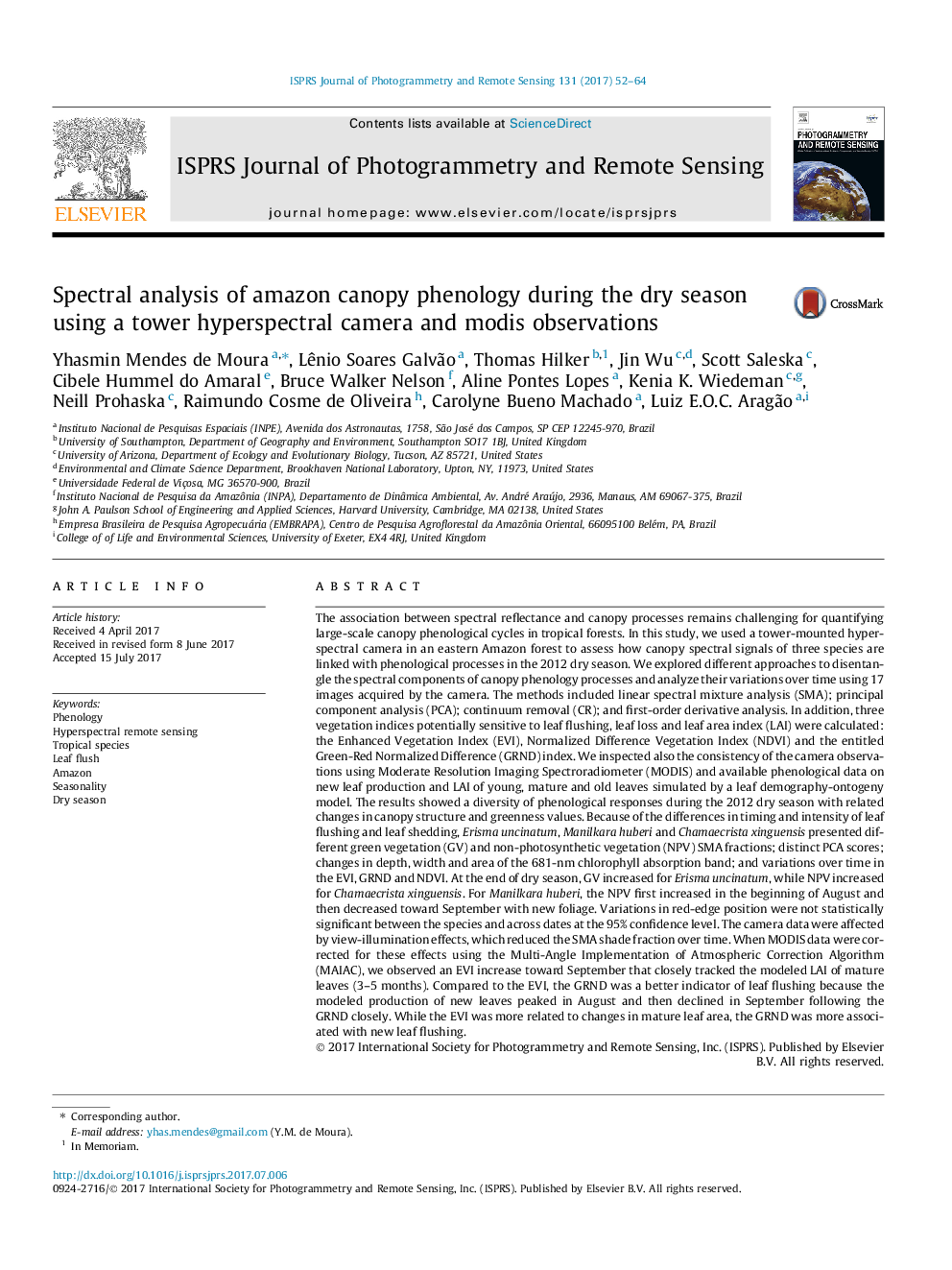| کد مقاله | کد نشریه | سال انتشار | مقاله انگلیسی | نسخه تمام متن |
|---|---|---|---|---|
| 4972780 | 1451243 | 2017 | 13 صفحه PDF | دانلود رایگان |
عنوان انگلیسی مقاله ISI
Spectral analysis of amazon canopy phenology during the dry season using a tower hyperspectral camera and modis observations
ترجمه فارسی عنوان
تجزیه و تحلیل طیفی فنولوژیکی سایبان آمازون در طول فصل خشک با استفاده از یک دوربین فوق العاده برج و مشاهدات مدیس
دانلود مقاله + سفارش ترجمه
دانلود مقاله ISI انگلیسی
رایگان برای ایرانیان
کلمات کلیدی
فنولوژی، سنجش از دور سنجی، گونه های گرمسیری، برگ فشرده، آمازون، فصلی، فصل خشک،
موضوعات مرتبط
مهندسی و علوم پایه
مهندسی کامپیوتر
سیستم های اطلاعاتی
چکیده انگلیسی
The association between spectral reflectance and canopy processes remains challenging for quantifying large-scale canopy phenological cycles in tropical forests. In this study, we used a tower-mounted hyperspectral camera in an eastern Amazon forest to assess how canopy spectral signals of three species are linked with phenological processes in the 2012 dry season. We explored different approaches to disentangle the spectral components of canopy phenology processes and analyze their variations over time using 17 images acquired by the camera. The methods included linear spectral mixture analysis (SMA); principal component analysis (PCA); continuum removal (CR); and first-order derivative analysis. In addition, three vegetation indices potentially sensitive to leaf flushing, leaf loss and leaf area index (LAI) were calculated: the Enhanced Vegetation Index (EVI), Normalized Difference Vegetation Index (NDVI) and the entitled Green-Red Normalized Difference (GRND) index. We inspected also the consistency of the camera observations using Moderate Resolution Imaging Spectroradiometer (MODIS) and available phenological data on new leaf production and LAI of young, mature and old leaves simulated by a leaf demography-ontogeny model. The results showed a diversity of phenological responses during the 2012 dry season with related changes in canopy structure and greenness values. Because of the differences in timing and intensity of leaf flushing and leaf shedding, Erisma uncinatum, Manilkara huberi and Chamaecrista xinguensis presented different green vegetation (GV) and non-photosynthetic vegetation (NPV) SMA fractions; distinct PCA scores; changes in depth, width and area of the 681-nm chlorophyll absorption band; and variations over time in the EVI, GRND and NDVI. At the end of dry season, GV increased for Erisma uncinatum, while NPV increased for Chamaecrista xinguensis. For Manilkara huberi, the NPV first increased in the beginning of August and then decreased toward September with new foliage. Variations in red-edge position were not statistically significant between the species and across dates at the 95% confidence level. The camera data were affected by view-illumination effects, which reduced the SMA shade fraction over time. When MODIS data were corrected for these effects using the Multi-Angle Implementation of Atmospheric Correction Algorithm (MAIAC), we observed an EVI increase toward September that closely tracked the modeled LAI of mature leaves (3-5Â months). Compared to the EVI, the GRND was a better indicator of leaf flushing because the modeled production of new leaves peaked in August and then declined in September following the GRND closely. While the EVI was more related to changes in mature leaf area, the GRND was more associated with new leaf flushing.
ناشر
Database: Elsevier - ScienceDirect (ساینس دایرکت)
Journal: ISPRS Journal of Photogrammetry and Remote Sensing - Volume 131, September 2017, Pages 52-64
Journal: ISPRS Journal of Photogrammetry and Remote Sensing - Volume 131, September 2017, Pages 52-64
نویسندگان
Yhasmin Mendes de Moura, Lênio Soares Galvão, Thomas Hilker, Jin Wu, Scott Saleska, Cibele Hummel do Amaral, Bruce Walker Nelson, Aline Pontes Lopes, Kenia K. Wiedeman, Neill Prohaska, Raimundo Cosme de Oliveira, Carolyne Bueno Machado,
